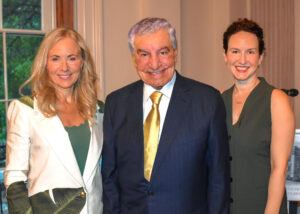Across East Africa, criminals are not just exploiting regulatory gaps to siphon public funds and smuggle natural resources, they are also trafficking antiquities—funneling stolen cultural goods into international markets. These crimes undermine security, hinder economic development, and disrupt future generations’ access to cultural heritage.
On July 9, the Antiquities Coalition and Transparency Advocacy, an organization combating transnational organized crime, illicit financial flows, and corruption based in Uganda, convened experts from across East Africa for the first installment of a new webinar series spotlighting the region’s fight against antiquities trafficking and illicit financial flows. The conversation revealed insight into the scale of the crisis and examples of leadership emerging from within the region—despite the uphill fight against corruption, conflict, and weak legal frameworks.
Panelists included Tabitha Agaba, Project Manager at Transparency Advocacy; George Juma Ondeng, Activist and Co-Founder of the Invisible Inventories Programme; and Abdiwahab Ahmed, Founding Director of Hayaan Heritage. Together, they delivered a powerful message: cultural racketeering in East Africa is not just a legacy of colonialism—it is a living threat that continues to rob communities of their cultural heritage.
Speakers emphasized that cultural goods are trafficked like any other illicit commodity—and must be treated accordingly by national and international law enforcement. Law enforcement officers in the region often lack training and awareness about cultural property crimes. Compounding this problem is the region’s limited adoption and implementation of international agreements.
Local Leaders, Global Relevance
Despite these systemic challenges, regional leaders are stepping up. Tabitha Agaba of Transparency Advocacy in Uganda is working to raise awareness about how the range of illicit flows, including cultural goods, is undermining economic stability and security in the region. She emphasized, however, that this is not just a matter of stolen goods, but stolen heritage.
George Juma Ondeng detailed the successes of the Invisible Inventories Programme, now compiling data on Kenyan artifacts in Western museums, building a foundation for future restitution efforts and international museum collaboration.
Abdiwahab Ahdmed of Hayaan Heritage—an organization dedicated to preserving, promoting, and celebrating the rich heritage of Somalia—celebrated the success of these locally-led initiatives and called for more institutional support, public awareness, and capacity building for this work.
The Road Ahead
So what are the next steps?
- Ratify the 1970 UNESCO Convention: Many countries in the region have not yet ratified the 1970 UNESCO Convention on deterring the illicit transfer of cultural property. This foundational step enables countries to better protect their cultural property and open international collaborations.
- Train law enforcement and customs officials: The law is only as strong as its enforcement. Speakers emphasized the need for national and municipal law enforcement training to broaden awareness of legal frameworks and cultural objects at risk.
- Build inventories and databases: As seen in Kenya with the Invisible Inventories Programme, knowing what was taken is the first step to getting it back.
- Foster international solidarity: Organizations across East Africa are doing remarkable work—but, as these are transnational crimes, enduring solutions require regional and international cooperation.
The Antiquities Coalition commends the leadership of Transparency Advocacy, the Invisible Inventories Programme, and Hayaan Heritage for advancing the fight against cultural racketeering. Their work is a reminder that protecting our shared heritage requires not only policy, but partnership.
As we continue this webinar series, we invite governments, museums, law enforcement, and civil society worldwide to listen, learn, and join in building a future where cultural heritage is protected—not plundered.
Stay tuned for the next installment in our Illicit Financial Flows and Antiquities Trafficking in East Africa webinar series.









